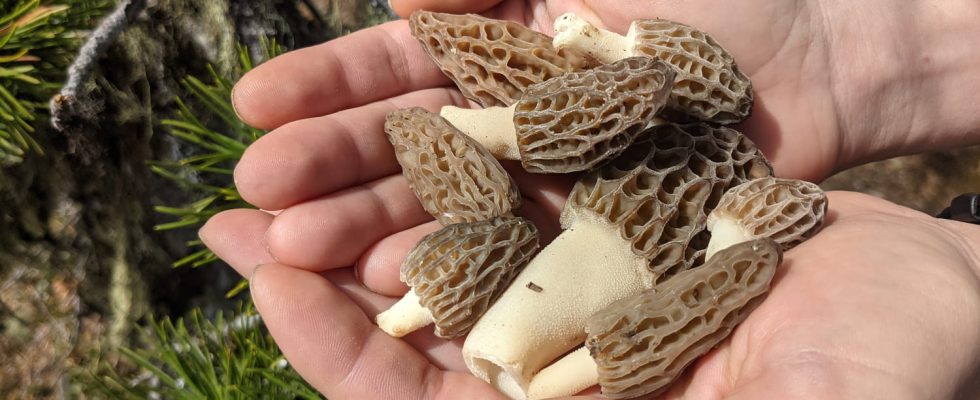Another mushroom is very similar but can be very toxic.
Spring is the season for morels, delicious mushrooms that enhance risottos, meats or omelettes. Notice to picking enthusiasts: edible morels can be easily confused with another mushroom who is toxic or even fatal. It is therefore important to remain vigilant, whether you are a connoisseur or someone who picks occasionally.
Fatal health risks
Nicknamed the “false morel”, the gyromitra (Gyromitra esculenta) is responsible for intoxications. It contains a toxic molecule (gyromitrin) which can damage the liver, kidneys and central nervous system. In France, the National Food Safety Agency (Handles) reports approximately a thousand poisonings due to fungi. Among these poisonings, several are due to confusion between an edible species and a toxic species. Generally in the event of poisoning, the person does not feel symptoms immediately, it is only after 6 to 24 hours that the first symptoms appear:
- stomach ache
- vomiting
- diarrhea
- headache
- severe fatigue
- confusion
- drowsiness
Consumed significantly (one dish may be enough according to the mycologists of the Chasseurs de Champignons site), the health consequences can be serious and lead to hospitalization with some severe digestive disorders, kidney complications, liver damage which may require a transplant. The intoxication fortunately progresses in the majority of cases towards recovery. In 10% of casesintoxication can be fatal or cause irreversible after-effects.
What is the difference between true and false morels?
► Hat shape: it is especially theaspect of the hat that makes the difference: that of the false morel is formed of “convolutions” often reddish-brown which resemble the sinuous folds of a brain. That of the real morel is cylindrical composed of well-designed juxtaposed cells with protruding edges. They are colored blonde to light brown and are hollow inside.
► Growing location: The false morel grows in coniferous forests on dead stumps or at the foot of trees. and she likes them acidic and humus-laden soils. The real morel particularly likes bright undergrowth but also Scots pines. It also grows in plowed land and sandy soils with limestone subsoilbut also in stony places like ruins.
Photo to distinguish them
Precautions for pickers
► During picking:
- Only collect mushrooms that you know perfectly : some highly toxic poisonous mushrooms closely resemble edible species. Attention, poisonous mushrooms can grow in the place where you collected edible mushrooms in another year
- At the slightest doubt on the condition or identification of one of the mushrooms harvested, do not consume the harvest before having it checked by a pharmacist or a mycology association
- Pick only specimens in good condition and remove the entire mushroom (stem and cap) to allow identification;
- Avoid picking up young specimens which have not finished forming, which encourages confusion, and old specimens which risk being damaged or colonized by worms or insects.
► After picking:
- Wash yourself thoroughly hands
- Take a photo of your harvest before cooking : it will be useful in the event of poisoning to decide on the appropriate treatment;
- Store the mushrooms, avoiding any contact with other foods, in the refrigerator (maximum 4°C) and consume within two days after picking;
- Never eat raw mushrooms and cook each species separately and sufficiently: 20 to 30 minutes in the pan or 15 minutes in boiling water with the cooking water discarded. This destroys parasites and bacteria, and makes certain species edible (shiitake, morels, certain boletus);
- Consume mushrooms in reasonable quantities, i.e. 150 to 200 grams per adult per week;
- Never offer picked mushrooms to young children and avoid seniors (high risk of dehydration and death in the event of poisoning) and pregnant women from consuming it (certain bacteria or parasites such as toxoplasmosis, which pose a risk to the fetus, are present in the earth and could infect them ) ;
- Do not consume mushrooms identified using a mushroom recognition application on a smartphone, due to the high risk of error.
- Do not consume mushrooms marketed by non-professionals, “on the sly”.
► In case of vital distress (loss of consciousness, respiratory distress, etc.), call 15 or 112.
► If symptoms appear following consumption of mushrooms (diarrhea, vomiting, nausea, tremors, dizziness, vision problems, etc.), immediately call a Poison Control Center, mentioning this consumption.
